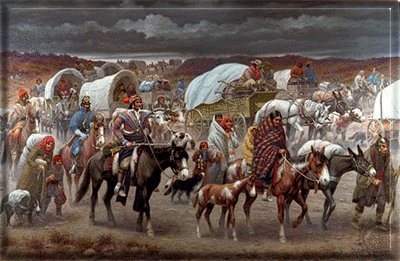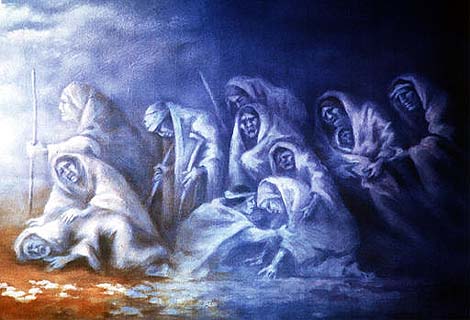|
|
Trail of Tears


EACH OF US NEEDS TO LEARN WHAT HAPPENED, HOW IT HAPPENED, SO IT NEVER HAPPEN AGAIN...
After the American Revolution the newly established states of Georgia, South Carolina, Alabama and Mississippi took the lead in forcing the Southeastern Indians into exile. By then the white populations of these states already greatly outnumbered the Indians, who now were living in relatively small enclaves. Yet even these domains were to be denied the Indians. The state governments, under pressure from their citizens, demanded the removal of the tribesmen to the regions far to the west. One rationale for their demands was that the tribes were uncivilized and therefore unworthy of maintaining their hold on land desired by white Christian farmers. Ironically, the Indians had, by then, adopted "civilization" and all its works. The remaining major tribes of the Southeast - the Choctaw, Chickasaw, Seminole, Creek and Cherokee - were known as the Five Civilized Tribes, and many of the natives had adopted both European agricultural methods and Christianity.
Many Americans, appraised of this assimilation by publicists from the tribes themselves and by missionaries who had long lived among them, championed the cause of the Five Civilized Tribes. But the real power to dispose of the Indians lands remained with the state governments, and they were adamant for removal. These governments, in the early 19th century, passed laws that "legalized" the eradication of the Indian communities and opened their lands to settlers. Such legislation even denied the Indians any right of appeal by depriving them of standing in court.
It was this denial of the Indians most fundamental rights that led to a celebrated confrontation between two branches of the federal government in the persons of the venerable chief justice of the United States, John Marshall, and the president, Andrew Jackson (served 1829 - 1837). A Georgia law depriving the Indians of their rights was argued up to the Supreme Court, where it was ruled unconstitutional. Jackson, who was determined to rid the eastern part of the nation of its Indian population, was reputed to have said of the decision: "John Marshall has rendered his decision; now let him enforce it."
Without the power of the federal executive behind him, Marshalls decision in favor of Indian right was, in effect, null and void. And on May 28, 1830 Jackson signed into law the Indian Removal Act, a bill requiring all Indians living east of the Mississippi to leave their homes and be relocated far to the west in what was called Indian Territory. Now the federal government moved swiftly and brutally to enforce the new legislation. The first to feel the impact were the Choctaws of Mississippi. Bribed by agents of the government, a minority of Choctaw leaders in 1830 signed the Treaty of Dancing Rabbit Creek. All of the Choctaw land in Mississippi was ceded in exchange for territories in Arkansas and Oklahoma.
Only eastern Choctaws managed to evade federal authorities and escape removal by scattering in small bands throughout the backwoods of Mississippi and Louisiana, there to live for decades on the periphery of non-Indian society. Early in the 20th century the federal government finally abandoned effort to expel those who remained. The Bureau of Indian Affairs established an agency among them in central Mississippi and purchased land there for a reservation.
In successive marches from 1830 to 1833, thousands of Choctaws set out on foot, under the watchful eyes of soldiers. These long, cold marches, difficult at best, were made worse by shortages of wagons, horses, blankets and food. Woefully inadequate funds were quickly exhausted, and along the way people began to die. By the time Oklahoma was reached, more than a quarter of the migrants had succumbed to hunger, disease, or exhaustion.
The journey was equally horrible for the other Southeastern tribes when their turn came. Between 1834 and 1838 most of the Creeks, Cherokees and Chickasaws suffered removal, as did many of the Seminoles. Some of the eastern Seminoles forged themselves into a guerrilla army and waged bloody warfare against federal troops to retain their foothold in the East. One war lasted for seven years, from 1835 to 1824; a second war, in the 1850s, was much shorter. For almost 30 years after the fighting stopped in 1856, the remnants of the eastern Seminole peoples lived in isolation.
Like the Seminoles, a minority of Cherokees remained in their region by fleeing to land that was inaccessible to the outside world and generally considered worthless. Before the 19th century ended, the eastern Cherokees were all living legally on reservation lands purchased for them by the Bureau of Indian Affairs in the mountains of North Carolina.
Although the tribes in their new Oklahoma territories never recovered the vitality of the old days, they did reassert their former way of life, albeit in somewhat diminished form. They established farms, built schools and churches, revived their political institutions, and the Cherokees resumed publication of their newspaper.

Accounts of the "Cherokee Trail of Tears"
Beneath the Underdog: Race, Religion and the "Trail of Tears"
Cherokee and Native American Links
Cherokee Removal Forts
Grandpa was an Indian Chief - Account of the "Trail of Tears"
Indian Removal and The Trail of Tears
The Cherokee "Trail of Tears 1838-1839
The Genocide of Native Americans - A Socialogical View
"The Principal People" The Trail of Tears
The Trail of Tears - Story of Private John G. Burnett
The Trail of Tears Index
The Trail of Tears - The Legend of the Cherokee Rose
The Trail Where They Cried - "nu na hi du na tlo hi lu i "
Trail of Tears - A Testimony To The Survival of an Original People
The Trail of Tears
The Trail of Tears State Park - Cape Girardeau, Missouri
The Trail of Tears - The Map
The Trail of Tears - "The place where they cried"
Trail of Tears
Trail of Tears
|
|
|
|
|
 Native American Nations
Native American Nations
